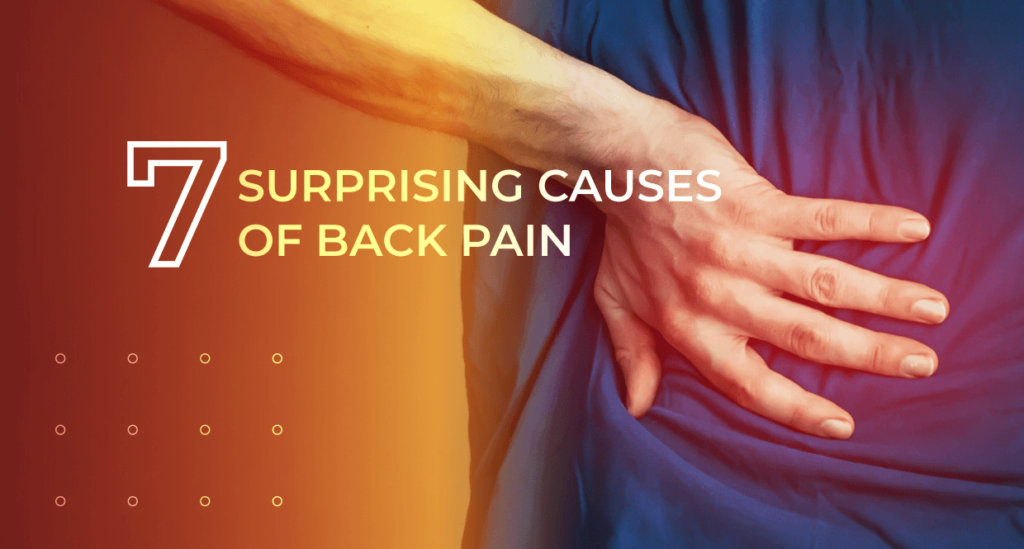
What Causes Back Pain? 7 Surprising Causes – and How to Find Relief
Fitness guru Denise Austin was fond of saying, “You’re spine is your lifeline!”
We couldn’t agree more, Denise.
The spine provides structural support (and supports your body weight), protects your spinal cord, and facilitates movement, from standing and sitting to bending, twisting, and every other movement that makes up your day – and your life. With such great responsibility, is it any wonder so many of us find ourselves with back pain?
Back pain is one of the most common medical problems in the U.S. Worldwide, back pain is the single leading cause of disability, preventing people from working – and from doing what they love. While the experience of back pain may be common – in fact, it’s almost universal: estimates are that about 80% of the population will experience back pain at some time in their lives – the causes can vary widely. Having your back pain properly diagnosed is essential to helping you move from back pain – to back pain relief.
7 Surprising Causes of Back Pain
Back pain can come on suddenly (acute back pain) or gradually, resolve quickly, or stick around long after the onset of symptoms (chronic back pain.) While an injury can result in immediate symptoms, for most of us, back pain appears gradually. One day you notice that getting out of bed in the morning, handling the household chores, lifting, bending, even driving or sitting at a desk, has become painful or difficult.
The most common conditions associated with back pain are:
- Muscle or ligament strains
- Herniated discs
- Spinal Stenosis
- Scoliosis
- Degenerative Disc Disease
- Accidents & Injuries
1. Lack of Sleep
How it Causes Back Pain:
Restorative sleep is essential to good health in so many ways. Restorative sleep flushes out lactic acid buildup in the muscles (a cause of stiffness and soreness) and helps rest and repair our brains so they can function optimally. Restorative sleep also powers our immune response, alertness, puts us in a better mood and even enhances libido. But how does lack of sleep cause back pain?
Decades of research has demonstrated that sleep deprivation not only heightens our sensitivity to pain, but long-term poor sleep quality contributes to a substantially increased risk of chronic and disabling back pain.
Throughout our day, water is released from our spinal discs – so much so that by the end of each day, we become ¼ to a ½ inch shorter than when we woke. Sleeping rehydrates them (and our heigh along with them.) A lack of sleep interrupts this process, leading to pain.
The quality and amount of sleep aren’t the only factors that contribute to back pain: where you sleep matters, too. Not having a supportive mattress and pillow can put stress on your spine and ligaments.

2. Vitamin D Deficiency
How it Causes Back Pain:
Back pain can be a symptom of inadequate levels of vitamin D, which helps maintain bone density by improving your body’s absorption of calcium. Your vitamin D levels are directly correlated with your connective tissue integrity. Low levels can make your joints unstable, while optimal levels of vitamin D help strengthen bones, protecting against back pain and disabling conditions like osteoarthritis. Extensive research published in International Association for the Study of Pain found that patients with the most severe back pain had the lowest levels of vitamin D. Research in the journal Menopause found that among women considering spine surgery, those with severe vitamin D deficiency had more severe disc degeneration and back pain. Getting the age and body type appropriate amount of nutrients into your diet is just as critical as exercise to reaching your wellness goals.
3. Smoking
How it Causes Back Pain:
You already know that smoking is terrible for your health, but the risks go far beyond your heart and lungs. According to research, both smoking cigarettes and vaping not only damages spinal tissue, it can also weaken bones and intensify back pain. The most common reason spinal fusion surgery patients don’t heal is because they are smokers (which is also why many insurance companies no longer cover back surgery for smokers).
Research also suggests that smoking alters the brain’s response to back pain, decreasing people’s resilience to it. Studies published in the journal Human Brain Mapping, found that smokers are three times more likely than nonsmokers to develop chronic back pain. Although pain meds helped study participants manage their pain, these substances could not change the brain’s response to it.
4. Stress
How it Causes Back Pain:
Almost as a great a risk to your overall health and wellness as smoking, stress can wreak havoc throughout the body. And we typically carry our stress in the neck and shoulder area, tension and misalignments in these areas (like what we see as a result of poor posture) can set off an inflammatory response, driving the pain farther down the back and hips. Stress can also trigger back pain or exacerbate the pain from an existing condition. For example, if you have a torn or herniated disc but aren’t yet experiencing symptoms, chronic stress can function as the “on” switch for the release of inflammatory molecules throughout your body, opening the floodgates for pain.
Staying active, giving your body adequate rest, proper nutrition and hydration, can all help you cope with the effects of stress.
5. Discrepancies in Leg Length
How it Causes Back Pain:
Perhaps less surprising than the others, having one leg longer than the other can certainly cause back pain. That’s because our leg lengths probably are not different – what we have are misalignments in our spine and joints. In fact, about 1 in 3 of us have leg length discrepancy caused by a misalignment in the pelvis, hip, knee, ankle, or foot that causes one leg to appear slightly shorter than the other. This is most often a result of how we use our body, altering the normal biomechanics of walking or standing.
The muscles we overuse every day tend to become chronically tight because we adopt an imbalanced movement pattern that weakens them, causing poor joint mechanics, abnormal spine curvature and misalignment. When one part shifts out of alignment, the rest of your body adjusts to balance you out. Leaning constantly on one hip, for example, shifts other body parts and joints of alignment. The more discrepancy, the more pain and the more unbalanced our gait can become – and the more likely you are to experience back pain (or find your back pain worsening with time.)
6. Weak Core Muscles
How it Causes Back Pain:
Your torso is stabilized by core muscles which work together to stabilize your spine. If your core is weak, you’re likely overworking other muscles, causing back pain and making you more prone to injury (even during simple movements). Weak abdominal muscles encourage you to lean forward, decreasing your stability during spinal movement. Since abdominals work in conjunction with back muscles, simple bending, lifting or reaching could make you more prone to back pain.
7. Excess Weight
How it Causes Back Pain:
Carrying excess body weight can significantly contribute to back pain. Remember that your spine supports your body weight, so excess weight is going to increase that pressure, straining the spine and surrounding joints. It can also affect your posture, causing you to slump, carry your head forward of your body (known as forward head carriage – a major cause of neck and upper back pain) and put pressure on the spinal discs, leading to damage and pain.
Simple Steps For Back Pain Relief
If you came here looking for back pain relief, there’s good news: nearly every surprising cause of back pain we’ve identified here can be addressed with simple lifestyle changes (although we realize that making a lifestyle change isn’t always simple – but we can help.) Quitting smoking, reducing stress levels (or finding healthier ways to respond), choosing a better mattress and pillow, releasing excess weight, and staying active can not only help you find back pain relief – they can help you improve nearly every area of your life.
For the other surprising causes of back pain – like leg length discrepancies and postural issues – relief can likely be found with chiropractic care.
Making changes but you want to feel better today? Get short-term relief with some of our favorite stretches for back pain.